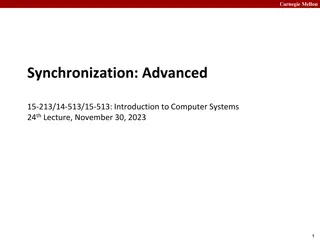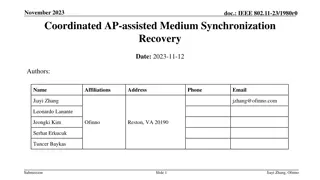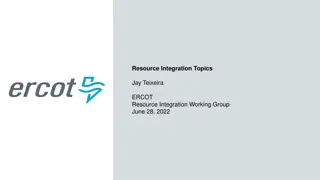PROCESS SYNCHRONIZATION
Concurrent access to shared data can lead to data inconsistency, requiring mechanisms for orderly process execution. Explore the critical-section problem, synchronization hardware, semaphores, and classical synchronization issues like the bounded-buffer problem. Discover solutions for maintaining data consistency and coordinating cooperating processes effectively.
Download Presentation

Please find below an Image/Link to download the presentation.
The content on the website is provided AS IS for your information and personal use only. It may not be sold, licensed, or shared on other websites without obtaining consent from the author.If you encounter any issues during the download, it is possible that the publisher has removed the file from their server.
You are allowed to download the files provided on this website for personal or commercial use, subject to the condition that they are used lawfully. All files are the property of their respective owners.
The content on the website is provided AS IS for your information and personal use only. It may not be sold, licensed, or shared on other websites without obtaining consent from the author.
E N D
Presentation Transcript
PROCESS SYNCHRONIZATION 2/20/2025
Process Synchronization Background The Critical-Section Problem Synchronization Hardware Semaphores Classical Problems of Synchronization 2/20/2025
Background Concurrent access to shared data may result in data inconsistency. Maintaining data consistency requires mechanisms to ensure the orderly execution of cooperating processes. Shared-memory solution to bounded-butter problem (Chapter 4) allows at most n 1 items in buffer at the same time. A solution, where all N buffers are used is not simple. Suppose that we modify the producer-consumer code by adding a variable counter, initialized to 0 and incremented each time a new item is added to the buffer 2/20/2025
Bounded-Buffer #define BUFFER_SIZE 10 typedef struct { . . . } item; item buffer[BUFFER_SIZE]; int in = 0; int out = 0; int counter = 0; 2/20/2025
Bounded-Buffer Producer process item nextProduced; while (1) { } while (counter == BUFFER_SIZE) ; /* do nothing */ buffer[in] = nextProduced; in = (in + 1) % BUFFER_SIZE; counter++; 2/20/2025
Bounded-Buffer Consumer process item nextConsumed; while (1) { } while (counter == 0) ; /* do nothing */ nextConsumed = buffer[out]; out = (out + 1) % BUFFER_SIZE; counter--; 2/20/2025
Bounded Buffer The statements counter++; counter--; must be performed atomically. Atomic operation means an operation that completes in its entirety without interruption. 2/20/2025
Bounded Buffer The statement count++ may be implemented in machine language as: register1 = counter register1 = register1 + 1 counter = register1 The statement count may be implemented as: register2 = counter register2 = register2 1 counter = register2 2/20/2025
Bounded Buffer If both the producer and consumer attempt to update the buffer concurrently, the assembly language statements may get interleaved. Interleaving depends upon how the producer and consumer processes are scheduled. 2/20/2025
Bounded Buffer Assume counter is initially 5. One interleaving of statements is: producer: register1 = counter (register1 = 5) producer: register1 = register1 + 1 (register1 = 6) consumer: register2 = counter (register2 = 5) consumer: register2 = register2 1 (register2 = 4) producer: counter = register1 (counter = 6) consumer: counter = register2 (counter = 4) The value of count may be either 4 or 6, where the correct result should be 5. 2/20/2025
Race Condition Race condition: The situation where several processes access and manipulate shared data concurrently. The final value of the shared data depends upon which process finishes last. To prevent race conditions, concurrent processes must be synchronized. 2/20/2025
Race Condition Race condition: The situation where several processes access and manipulate shared data concurrently. The final value of the shared data depends upon which process finishes last. To prevent race conditions, concurrent processes must be synchronized. 2/20/2025
The Critical-Section Problem n processes all competing to use some shared data Each process has a code segment, called critical section, in which the shared data is accessed. Problem ensure that when one process is executing in its critical section, no other process is allowed to execute in its critical section. 2/20/2025
Solution to Critical-Section Problem 1.Mutual Exclusion. If process Pi is executing in its critical section, then no other processes can be executing in their critical sections. 2. Progress. If no process is executing in its critical section and there exist some processes that wish to enter their critical section, then the selection of the processes that will enter the critical section next cannot be postponed indefinitely. 2/20/2025
Bounded Waiting. A bound must exist on the number of times that other processes are allowed to enter their critical sections after a process has made a request to enter its critical section and before that request is granted. Assume that each process executes at a nonzero speed No assumption concerning relative speed of the n processes. 2/20/2025























